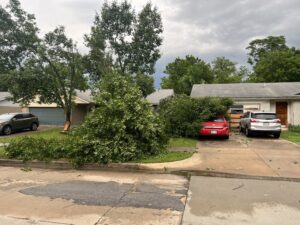By Kristi Howard
Special to Sapulpa Times
In Oklahoma, March 15 through June 15 is called “tornado season.” Even though tornadoes and severe thunderstorms can occur in our state at any time of the year, that time frame is historically when we tend to have the most tornadoes each year.
It’s rather easy to ignore tornado preparedness, as many towns in our state are spared of the devastation. It also doesn’t help that some weather forecasts will mention a “major event” for a week, and when that day arrives, nothing happens. We get into a mindset of not believing the weather forecasts, because “On this day, they were wrong, so why would they be right this time?”
Tornado preparedness is a discussion that all of us should have with our families, at the very least, once a year. In my family, it was twice a year. Having this discussion now, when there are no threats of severe weather, will help you face the possibility of a tornado with a calmer mind. Yelling orders at each other when there is a tornado reportedly five miles west of you is not the time to discuss your storm plans.
The first thing is to make sure that you are aware of the particular weather lingo. In any weather event, a WATCH means that conditions are favorable for whatever the watch is issued for in a given area. In other words, it may or may not happen, but all of the elements are coming together to where it could—stay wary. A WARNING means that the situation has either been confirmed by radar, or has been confirmed by a spotter or chaser in the field.
For example, a severe thunderstorm watch means that a severe thunderstorm could occur in the area that the watch has been issued for. For most people this means to bring an umbrella to work, check in to the radio or television every now and then for an update, and just know it’s a possibility. A severe thunderstorm warning means that a storm has reached the levels required to be considered severe, and you should stay indoors and away from windows, and take down hanging flower pots in case of strong wind, park you car in the garage in case it hails, etc. During tornado season, you should always keep in the back of your mind that a severe thunderstorm can become strong enough to produce a tornado, so you should take time considering what you need to be doing should a tornado warning get issued.
So, what do you do to get ready? Here is a brief list of things that we should do.
What to do at home
Have a “tornado kit” ready and put in your safe place in your home. Good items a tornado kit should have would be
Battery-powered or crank-powered radio. A weather radio is also recommended.
Flashlights.
Extra batteries for the battery-powered items.
Blankets, sturdy shoes, long pants and long-sleeved shirts.
Helmets. From bicycle to football, if you have them, wear them to help protect your head.
Canned goods, bottled water, pet food if you have pets, leashes and harnesses for pets.
Identification. Tags for your pets. Insurance information for health and home.
A fully-charged phone and battery chargers for your phone.
Weather apps for your phone. We use several, which I will share later on.
A first aid kit.
Have a designated area in your home to go to during a tornado warning. Ideally, you would be able to go into a basement, storm cellar, or safe room. If you do not have this, you should make sure that where you take shelter is on the lowest floor, in the center-most part of your home, away from windows and doors. This can vary depending on your home’s construction.
Do not open windows because of the “pressure.” This used to be something that was commonplace, but it has since been disproven. Spend that time getting everyone into the safe place, and grabbing blankets, and even a mattress if you can, to put over yourself.
If you live in a mobile home, go to the emergency shelter in your park. If you do not have a park shelter or you don’t live on a property with a shelter,be thinking in advance where you can go if a tornado warning is for your area. Mobile homes WILL become mobile if a tornado hits them.
What to do at work
Find out where the designated emergency shelter is at work. Take a moment to consider the best route to the area in the event of panicked co-workers. If there is no designated emergency shelter, apply the rules you would use at home; lowest floor, center-most room with no windows and doors, etc.
Make sure that your phone is fully charged.
Have an actual list of phone numbers in your purse or wallet should your phone get damaged, so you can give it to emergency personnel or use yourself to contact loved ones.
What to do in your car
NEVER stay in your car during a tornadic storm. Tornadoes can change their path with no visible indication (to the untrained eye). Leave your car and find shelter inside a building.
If you cannot find a building for shelter, DO NOT take shelter under an overpass. We have all seen the video of the father and two girls who hid under the overpass and survived. Divine intervention was the only reason they did survive. If you take shelter under an overpass, the wind would more likely suck you out of the underpass.
It doesn’t sound safer, but your best bet,is to get out of your car, find the lowest spot possible, like a ditch or a ravine, and lie face down, flat to the ground, with your hands clasped tightly behind your head to help protect your head.










